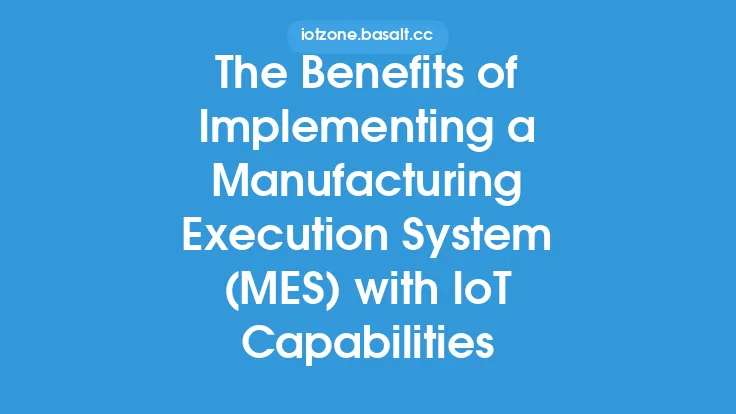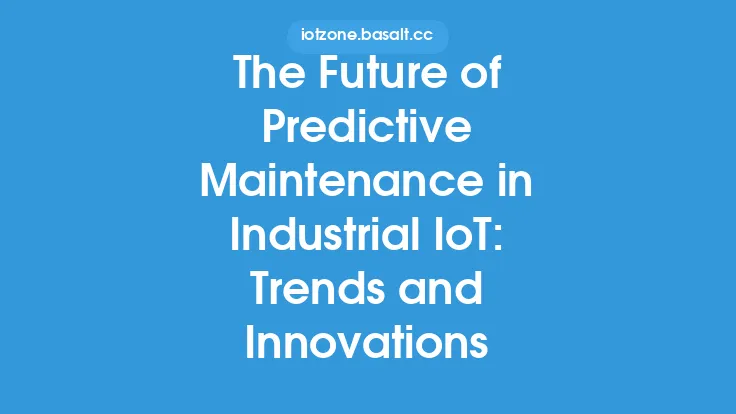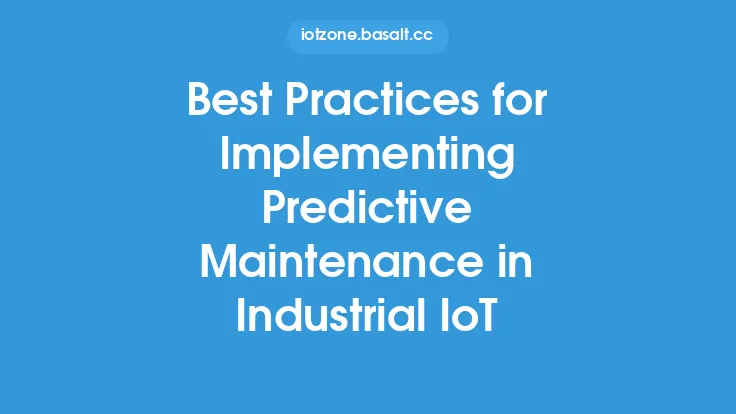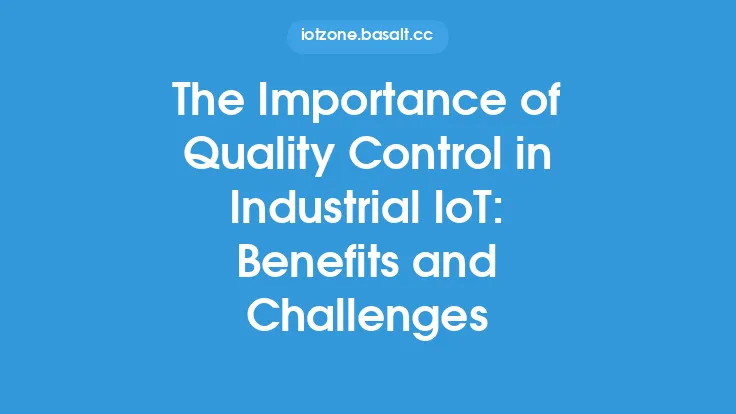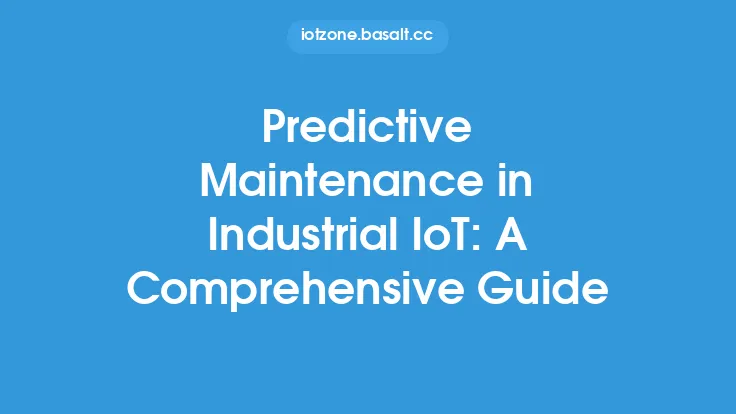Implementing a predictive maintenance strategy is a crucial aspect of modern industrial operations, as it enables companies to reduce downtime, increase efficiency, and improve overall equipment reliability. At its core, predictive maintenance involves using advanced technologies, such as sensors, machine learning algorithms, and data analytics, to monitor equipment performance and predict when maintenance is required. This approach allows companies to move away from traditional reactive maintenance methods, which can be costly and time-consuming, and instead adopt a proactive approach that minimizes disruptions and optimizes resource allocation.
Introduction to Predictive Maintenance
Predictive maintenance is a type of maintenance that uses data and analytics to predict when equipment is likely to fail or require maintenance. This approach is based on the idea that equipment degradation is a gradual process that can be monitored and predicted using various sensors and data analysis techniques. By analyzing data from sensors, such as vibration, temperature, and pressure sensors, companies can identify patterns and anomalies that indicate potential equipment failures. This information can then be used to schedule maintenance activities, reducing the likelihood of unexpected downtime and minimizing the impact of equipment failures on overall operations.
Key Components of a Predictive Maintenance Strategy
A predictive maintenance strategy typically consists of several key components, including data collection, data analysis, and decision-making. Data collection involves gathering data from various sources, such as sensors, equipment logs, and maintenance records. This data is then analyzed using machine learning algorithms and statistical models to identify patterns and trends that indicate potential equipment failures. The results of this analysis are then used to inform decision-making, such as scheduling maintenance activities, ordering replacement parts, and allocating resources. Other key components of a predictive maintenance strategy include data visualization, reporting, and alerts, which enable companies to quickly identify potential issues and take corrective action.
Technologies Used in Predictive Maintenance
Several technologies are used in predictive maintenance, including sensors, machine learning algorithms, and data analytics software. Sensors are used to collect data on equipment performance, such as vibration, temperature, and pressure. This data is then transmitted to a central location, where it is analyzed using machine learning algorithms and statistical models. Machine learning algorithms, such as neural networks and decision trees, are used to identify patterns and trends in the data that indicate potential equipment failures. Data analytics software, such as predictive analytics platforms and business intelligence tools, are used to analyze and visualize the data, providing insights and recommendations for maintenance activities.
Benefits of Predictive Maintenance
The benefits of predictive maintenance are numerous and well-documented. One of the primary benefits is reduced downtime, as predictive maintenance enables companies to identify potential equipment failures before they occur. This reduces the likelihood of unexpected downtime, which can be costly and disruptive to operations. Predictive maintenance also improves equipment reliability, as maintenance activities are scheduled based on actual equipment condition rather than a fixed schedule. This approach also reduces maintenance costs, as companies can avoid unnecessary maintenance activities and minimize waste. Other benefits of predictive maintenance include improved resource allocation, reduced energy consumption, and enhanced safety.
Implementation Considerations
Implementing a predictive maintenance strategy requires careful consideration of several factors, including data quality, equipment condition, and resource allocation. Data quality is critical, as predictive maintenance relies on accurate and reliable data to make predictions. Equipment condition is also important, as predictive maintenance is most effective when equipment is in good working condition. Resource allocation is another key consideration, as companies must ensure that they have the necessary resources, such as personnel and budget, to implement and maintain a predictive maintenance strategy. Other implementation considerations include change management, training, and cultural adoption, as predictive maintenance requires a cultural shift from reactive to proactive maintenance.
Common Challenges and Limitations
Despite the benefits of predictive maintenance, there are several common challenges and limitations that companies may encounter. One of the primary challenges is data quality, as predictive maintenance requires high-quality data to make accurate predictions. Equipment complexity is another challenge, as some equipment may be difficult to monitor or analyze. Resource constraints, such as budget and personnel, can also limit the effectiveness of predictive maintenance. Other common challenges and limitations include cultural resistance, lack of standardization, and integration with existing systems. To overcome these challenges, companies must carefully plan and execute their predictive maintenance strategy, ensuring that they have the necessary resources, expertise, and support to succeed.
Real-World Applications and Case Studies
Predictive maintenance has numerous real-world applications and case studies, demonstrating its effectiveness in various industries and settings. For example, a manufacturing company used predictive maintenance to reduce downtime by 50% and improve overall equipment effectiveness by 20%. A utility company used predictive maintenance to reduce maintenance costs by 30% and improve asset reliability by 25%. Other examples include a transportation company that used predictive maintenance to reduce maintenance costs by 20% and improve vehicle availability by 15%, and a healthcare organization that used predictive maintenance to reduce equipment downtime by 40% and improve patient care by 10%. These case studies demonstrate the potential of predictive maintenance to drive business value and improve operational efficiency.
Conclusion and Future Directions
In conclusion, implementing a predictive maintenance strategy is a critical aspect of modern industrial operations, enabling companies to reduce downtime, improve efficiency, and enhance equipment reliability. By leveraging advanced technologies, such as sensors, machine learning algorithms, and data analytics, companies can move away from traditional reactive maintenance methods and adopt a proactive approach that minimizes disruptions and optimizes resource allocation. As the industrial IoT continues to evolve, we can expect to see even more innovative applications of predictive maintenance, including the use of artificial intelligence, blockchain, and other emerging technologies. By staying at the forefront of these developments, companies can unlock new opportunities for growth, improvement, and innovation, and remain competitive in an increasingly complex and dynamic industrial landscape.
